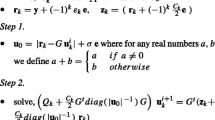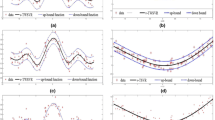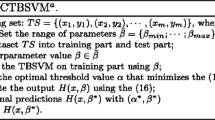Abstract
Twin support vector regression (TSVR) determines a pair of \(\epsilon\)-insensitive up- and down-bound functions by solving two related support vector machine-type problems, each of which is smaller than that in a classical SVR. On the lines of TSVR, we have proposed a novel regressor for the simultaneous learning of a function and its derivatives, termed as TSVR of a Function and its Derivatives. Results over several functions of more than one variable demonstrate its effectiveness over other existing approaches in terms of improving the estimation accuracy and reducing run time complexity.








Similar content being viewed by others
References
Antonio J, Martìn H, Santos M, Lope J (2010) Orthogonal variant moments features in image analysis. Inform Sci 180:846–860
Burges C (1998) A tutorial on support vector machines for pattern recognition. Data Min Knowl Discov 2(2):121–167
Beauchemin SS, Barron JL (1995) The computation of optical flow. ACM, New York
Chen C, Zhang J, He X, Zhou Z (2011) Non-parametric Kernel learning with robust pairwise constraints. Int J Mach Learn Cybern. doi:10.1007/s13042-011-0048-6
Christianini N, Shawe-Taylor J (2000) An intorduction to support vector machines. Cambridge University Press, Cambridge
Ebrahimi T, Garcia G, Vesin J (2002) Joint time-frequency-space classification of EEG in a brain–computer interface appplication. J Apply Signal Process 1:713–729
Fung G, Mangasarian OL (2001) Incremental support vector machine classification. In: 7th ACM SIGKDD international conference on knowledge discovery and data mining, pp 77–86
Golub GH, Van Loan CF (1996) Matrix computations, 3rd edn. The John Hopkins Univ. Press, Maryland
He F, IAENG M, Yeung LM, Brown M (2008) Discrete-Time Model Representation for Biochemical Pathway Systems. IAENG Int J Comput Sci 34(1):1–15
Ince H, Trafalis TB (2000) Support vector machine for regression and applications to financial forecasting, In: International joint conference on neural networks, IJCNN, vol 6, pp 348–353
Jayadeva, Khemchandani R, Chandra S (2006) Regularized least squares twin SVR for the simultaneous learning of a function and its derivative, IJCNN, pp 1192–1197
Jayadeva, Khemchandani R, Chandra S (2007) Twin support vector machines for pattern classification. IEEE Trans Pattern Anal Mach Intell 29:905–910
Jayadeva, Khemchandani R, Chandra S (2008) Regularized least squares support vector regression for the simultaneous learning of a function and its derivatives. Inform Sci 178:3402–3414
Joachims T (1999) Making large-scale SVM learning practical. In: Advances in kernel methods: support vector learning. MIT Press, Cambridge
Julier SJ, Uhlmann JK (2004) Unscented filtering and nonlinear estimation. In: Proceedings of the IEEE, pp 401–422
Khemchandani R, Jayadeva, Chandra S (2009) Regularized least squares fuzzy support vector regression for financial time series forecasting. Exp Syst Appl 36:132–138
Lagaris IE, Likas A, Fotiadis D (1998) Artificial neural networks for solving ordinary and partial differential equations. IEEE Trans Neural Netw 9:987–1000
Lengagne R (2000) 3D stereo reconstruction of human faces driven by differential constraints. Image Vis Comput 18:337-343
Lázaro M, Santamaŕia I, Pérez-Cruz F, Artés-Rodŕiguez A (2005) Support vector regression for the simultaneous learning of a multivariate function and its derivative. Neurocomputing 69:42–61
Lázaro M, Santamaria I, Pérez-Cruz F, Artés-Rodriguez A (2003) SVM for the simultaneous approximation of a function and its derivative. In: Proceedings of the 2003 IEEE international workshop on neural networks for signal processing (NNSP), Toulouse, France, pp 189–198
Mangasarian OL (1998) Nonlinear programming. SIAM
Liu Z, Wu Q, Zhang Y, Chen CLP (2011) Adaptive least squares support vector machines filter for hand tremor canceling in microsurgery. Int J Mach Learn Cybern 2(1):37–47
Mees AI, Jackson MF, Chua LO (1992) Device modeling by radial basis function. IEEE Trans Circuits Syst I Fundam Theory Appl 39:19–27
Osuna E, Freund R, Girosi F (1997) Training support vector machines: an application to face detection. In: IEEE computer society conference on computer vision and pattern recognition, pp 130–136
Peng X (2009) TSVR: an efficient twin support vector machine for regression. Neural Netw 23:365–372
Pérez-Cruz F, Bousono-Calzón C, Artés-Rodriguez A (2005) Convergence of the IRWLS procedure to the support vector machine solution. Neural Comput 17:7–18
Schmidt M, Lipson H (2009) Distilling free-form natural laws from experimental data. Science 324(5923):81–85
Kemelmacher-Shlizerman I, Basri R (2011) 3D face reconstruction from a single image using a single reference face shape. IEEE Trans Pattern Anal Mach Intell 33(2):394–405
Vapnik VN (1995) The nature of statistical learning theory. Springer, Berlin
Vapnik VN (1998) Statistical learning theory. Wiley, NY
Wang Z, Lu S, Zhai J (2008) Fast fuzzy multi-category SVM based on support vector domain description. Int J Pattern Recogn Artif Intell 22(1):109–120
Xiao JZ, Wang HR, Yang X, Gao Z (2011) Multiple faults diagnosis in motion system based on SVM. Int J Mach Learn Cybern. doi:10.1007/s13042-011-0035-y
Zheng S (2011) Gradient descent algorithms for quantile regression with smooth approximation. Int J Mach Learn Cybern 2(3):191–207
Author information
Authors and Affiliations
Corresponding author
Rights and permissions
About this article
Cite this article
Khemchandani, R., Karpatne, A. & Chandra, S. Twin support vector regression for the simultaneous learning of a function and its derivatives. Int. J. Mach. Learn. & Cyber. 4, 51–63 (2013). https://doi.org/10.1007/s13042-012-0072-1
Received:
Accepted:
Published:
Issue Date:
DOI: https://doi.org/10.1007/s13042-012-0072-1




